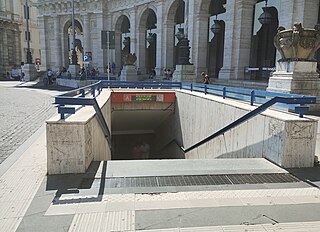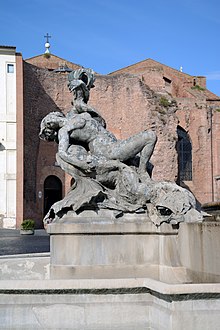
Fontana del Tritone is a seventeenth-century fountain in Rome, by the Baroque sculptor Gian Lorenzo Bernini. Commissioned by his patron, Pope Urban VIII, the fountain is located in the Piazza Barberini, near the entrance to the Palazzo Barberini that Bernini helped to design and construct for the Barberini, Urban's family. This fountain should be distinguished from the nearby Fontana dei Tritoni by Carlo Francesco Bizzaccheri in Piazza Bocca della Verità which features two Tritons.

Castro Pretorio is the 18th rione of Rome, Italy, identified by the initials R. XVIII, and it is located within the Municipio I. The rione takes its name by the ruins of the Castrum Praetorium, the barracks of the Praetorian Guard, included in the Aurelian Walls.

Giacomo della Porta (1532–1602) was an Italian architect and sculptor, who worked on many important buildings in Rome, including St. Peter's Basilica. He was born at Porlezza, Lombardy and died in Rome.

Piazza del Popolo is a large urban square in Rome. The name in modern Italian literally means "People's Square", but historically it derives from the poplars after which the church of Santa Maria del Popolo, in the northeast corner of the piazza, takes its name.

The Fontana della Piazza dei Quiriti is a fountain in the Piazza dei Quiriti in Rome, in the middle of the Prati rione. The plaza is named after the inhabitants of the city of Cures, the Curites or later Quirites, namely the Sabines, who became inhabitants and co-founders of Rome. Another theory derives the name from the god Quirinus, a Roman deity.

The fountain in the Piazza d'Aracoeli is a fountain in Rome, Italy, located at the base of the Capitoline Hill, in the little square with the same name.

The fountain in the Piazza Colonna is a fountain in Rome, Italy, designed by the architect Giacomo Della Porta and constructed by the Fiesole sculptor Rocco Rossi between 1575 and 1577.

The Fontana delle Anfore, located in Testaccio, a quarter of Rome, Italy. It was completed in 1927, by Pietro Lombardi after he won a competition the municipality of Rome set in 1924 for new local fountains. The motive of the amphorae refers to the Monte Testaccio and to the symbol of the whole quarter.

Barberini–Fontana di Trevi is an underground station on Line A of the Rome Metro, inaugurated in 1980 and situated under Piazza Barberini in Trevi. Originally, the station was simply named Barberini, and the name was extended in 2000.

Repubblica–Teatro dell'Opera is an underground station on Line A of the Rome Metro. The station was inaugurated in 1980 and takes its name from the Piazza della Repubblica underneath which it lies.

Piazza Barberini is a large piazza in the centro storico or city center of Rome, Italy and situated on the Quirinal Hill. It was created in the 16th century but many of the surrounding buildings have subsequently been rebuilt.

Piazza della Repubblica is a circular piazza in Rome, at the summit of the Viminal Hill, next to the Termini station. On it is to be found Santa Maria degli Angeli e dei Martiri. It is served by the Repubblica – Teatro dell'Opera Metro station. From the square starts one of the main streets of Rome, Via Nazionale.

Mario Rutelli was an Italian sculptor.

The Fountain of Neptune is a fountain in Rome, Italy, located at the north end of the Piazza Navona.

The Fontana Maggiore, a masterpiece of medieval sculpture, placed in the centre of Piazza IV Novembre, is the monument symbol of the city of Perugia.

The Fontana delle Tartarughe is a fountain of the late Italian Renaissance, located in Piazza Mattei, in the Sant'Angelo district of Rome, Italy. It was built between 1580 and 1588 by the architect Giacomo della Porta and the sculptor Taddeo Landini. The bronze turtles around the upper basin, usually attributed either to Gian Lorenzo Bernini or Andrea Sacchi, were added in either 1658 or 1659 when the fountain was restored.

The Fountain of Neptune is a monumental fountain, located in Municipio square, in Naples, Italy. The fountain until the end of 2014 was located across the street of via Medina across from the church of Santa Maria Incoronata, Naples and a few doors south of the church complex of Pieta di Turchini. Now the fountain is located in front of the Town hill building, its location changed due to the construction of the new underground station.

The Fountain of the Tritons is a fountain in Rome (Italy), Piazza Bocca della Verità, in front of the basilica of Santa Maria in Cosmedin. This fountain should be distinguished from the similarly named nearby Triton Fountain by Gian Lorenzo Bernini, in the Piazza Barberini, with only a single Triton.

The Fontana della Navicella is a fountain built around a marble and travertine replica of an Ancient Roman sculpture, depicting a decorated Roman Galley, and erected in front of the church of Santa Maria in Domnica of Rome, Italy. While the statue is a copy (1518–1519) made by Andrea Sansovino on commission from Pope Leo X based on fragments discovered near the church.

























